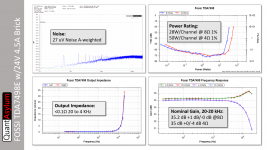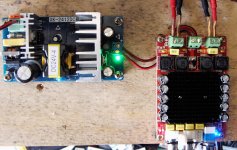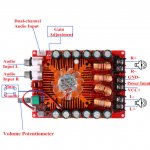Now I'm confused...It should be 25.6db (according to the datasheet) and that is the lowest gain.
At which setting is the amp at it's loudest? The most left setting, or the most right one?
So the 21,6dB is a typo and should read 25,6?
That actually makes more sense, as the steps between the settings are more equal, in stead of the 6 dB, 4,5dB and 2 dB the numbers in the link suggest.
Regards, Jan.
The noise output from these TDA7498 amps is really low--about -91 dBV A weighted on the highest gain. So, even if you are using really efficient speakers, you shouldn't hear anything from the speakers even with gain set to max and inputs shorted. 50W into 4 ohms means 23 dBV into the speakers, and so if your DAC can do 0 dBV max output, then the lowest gain setting would require full volume to get to 1% distortion.
Not sure about that ebay design in particular, but in the attached plot, look at the output rolloff from 10 to 20K into 4 ohms. The manufacturers have to pick if they are going to drive 4 or 8 ohms. But as you can see, the way to serve both is to compromise so that the 8 ohm load results in peaking and the 4 ohm load results in premature rolloff.
Not sure about that ebay design in particular, but in the attached plot, look at the output rolloff from 10 to 20K into 4 ohms. The manufacturers have to pick if they are going to drive 4 or 8 ohms. But as you can see, the way to serve both is to compromise so that the 8 ohm load results in peaking and the 4 ohm load results in premature rolloff.
Attachments
Min - most left, Max - most right.
Sorry Jan, the gain values on the board are some 4db lower than in the datasheet. Could be due to some loss (4dB) from the implementation.
Min - most left, Max - most right.
As I was still confused as to which was which, I hooked up the board with the 24V DC SMSP onto my PC soundcard and played around with the gain settings.
At the lowest setting 21,6dB (according to the link) the amp is the loudest, at the maximum setting: 33,3dB, the amp is less loud; I can turn up the volume all the way without getting distortion from the speakers (4 Ohm).
So: the lowest setting results in the highest gain and the highest setting is the lowest gain.
Glad I figured that out...
-------------------------------------------------------------------------------------------------
I wonder if I should replace the 35V caps for the 50V ones and go to 35V powersupply, as the amp is loud enough for the nearfield application I'm currently listening to.
Will the bigger powersupply make any difference in sound quality, or will I just have more reserve in terms of volume?
I added a picture of the set-up I'm listening to at the moment, the input has a Y-cable feeding the fullrange signal into a subwoofer filter, followed by a 200W IRS2092 on 50V, powering a bandpass sub under my desk.
Regards, Jan.
Attachments
Last edited:
A......
At the lowest setting 21,6dB (according to the link) the amp is the loudest, at the maximum setting: 33,3dB, the amp is less loud; I can turn up the volume all the way without getting distortion from the speakers (4 Ohm).
So: the lowest setting results in the highest gain and the highest setting is the lowest gain.
Regards, Jan.
hi JAN
normaly the Gain is the Gain.
low gain = low voltage "swing" possible
high gain = higher voltage "swing" -- louder
i guess that the picture (zek) where you can see the red switches up/down is maybe not correct....maybe the "white" position is counting the gain...
but now you know which setting you need/prefer
chris
Last edited:
As I was still confused as to which was which, I hooked up the board with the 24V DC SMSP onto my PC soundcard and played around with the gain settings.
At the lowest setting 21,6dB (according to the link) the amp is the loudest, at the maximum setting: 33,3dB, the amp is less loud; I can turn up the volume all the way without getting distortion from the speakers (4 Ohm).
So: the lowest setting results in the highest gain and the highest setting is the lowest gain.
Glad I figured that out...
-------------------------------------------------------------------------------------------------
I wonder if I should replace the 35V caps for the 50V ones and go to 35V powersupply, as the amp is loud enough for the nearfield application I'm currently listening to.
Will the bigger powersupply make any difference in sound quality, or will I just have more reserve in terms of volume?
I added a picture of the set-up I'm listening to at the moment, the input has a Y-cable feeding the fullrange signal into a subwoofer filter, followed by a 200W IRS2092 on 50V, powering a bandpass sub under my desk.
Regards, Jan.
Hi
At your picture is see how you connect the speakers !!!

please make the cabel insulation once again- the blank copper is not good-it looks as a stiff cable but avoid the reason of a short cut !
chris
Does anyone know how or if I can leach power from the 12v supply that powers the fan? I would like to power a DSP board from it if possible.
It is mentioned earlier that there is an LM2596 chip on board?
After extensive squinting and a hell of a lot of googling of partial chip number names....
XL4001 is the step down chip on this board. The chip on my board has smudged writing which didn't help at all!
After extensive squinting and a hell of a lot of googling of partial chip number names....
XL4001 is the step down chip on this board. The chip on my board has smudged writing which didn't help at all!
Hi Graham,
I have the same board and on mine there is an XL4001. The current capability is very limited in particular due to the very small Buck choke. A plain guess, in the order of 100mA. I wouldn't use that voltage for anything else.
Hi Graham,
I have the same board and on mine there is an XL4001. The current capability is very limited in particular due to the very small Buck choke. A plain guess, in the order of 100mA. I wouldn't use that voltage for anything else.
Ah I see. I did a quick test and the adau1701 board fires up but I didnt check any audio signals.
Would changing the choke make a difference?
As can be seen here I am struggling to get 12v to this dsp without an incredibly hot step down board.
TDA7498E + Sure ADAU1701 DC Step Down
The XL4001 is stated to do 2-3A. So, in principle you can pull more current with a (much) bigger coil. You may also have to change the input and output capacitors.
Your concern is to have (heterodyne) beat frequencies from the use of two non-synchronized SMPS. That is possible, the real practical problem from that I cannot predict.
You have a possibility of disabling the small SMPS on-board, buy a more powerful Buck-module and use that voltage for the amplifier board as well.
Your concern is to have (heterodyne) beat frequencies from the use of two non-synchronized SMPS. That is possible, the real practical problem from that I cannot predict.
You have a possibility of disabling the small SMPS on-board, buy a more powerful Buck-module and use that voltage for the amplifier board as well.
hi
lot of guys here tried a lot of Class D amps, TDA7492--big brother 7498, + the IRS amps...any difference of SQ at the this low cost boards compared to the new TPA......TPA3255.
i am asking because
perfk 1 Stucke Mini Verstarker Mini Audio: Amazon.de: Elektronik
:...complete amp 24Euro TDA7498...to play around....and mod
i found some pic in the net...its a normal TD7498 yellow board
thx chris
lot of guys here tried a lot of Class D amps, TDA7492--big brother 7498, + the IRS amps...any difference of SQ at the this low cost boards compared to the new TPA......TPA3255.
i am asking because
perfk 1 Stucke Mini Verstarker Mini Audio: Amazon.de: Elektronik
:...complete amp 24Euro TDA7498...to play around....and mod
i found some pic in the net...its a normal TD7498 yellow board
thx chris
Hi Chris,
As you know, the TPA3255 is "the top of the pop" for monolithic class D amplifiers. In particular characterized by a powerful bass (Kaffiman). The TDA7498 is really value for money and you can have a lot of fun from doing experiments with it. But, you can only expect the TPA3255 to come out as the winner when you compare details.
Also the TPA3255 data are superior.
As you know, the TPA3255 is "the top of the pop" for monolithic class D amplifiers. In particular characterized by a powerful bass (Kaffiman). The TDA7498 is really value for money and you can have a lot of fun from doing experiments with it. But, you can only expect the TPA3255 to come out as the winner when you compare details.
Also the TPA3255 data are superior.
Hi Chris,
As you know, the TPA3255 is "the top of the pop" for monolithic class D amplifiers. In particular characterized by a powerful bass (Kaffiman). The TDA7498 is really value for money and you can have a lot of fun from doing experiments with it. But, you can only expect the TPA3255 to come out as the winner when you compare details.
Also the TPA3255 data are superior.
hmmm... i see at the 7498 datasheet 4amps max- and the "little" tpa3250(fx502spro) can 14amps.
hi
lot of guys here tried a lot of Class D amps, TDA7492--big brother 7498, + the IRS amps...any difference of SQ at the this low cost boards compared to the new TPA......TPA3255.
i am asking because
perfk 1 Stucke Mini Verstarker Mini Audio: Amazon.de: Elektronik
:...complete amp 24Euro TDA7498...to play around....and mod
i found some pic in the net...its a normal TD7498 yellow board
thx chris
I have a few 3116 amps, a 7498, one 3118 and a 3255 amp boards .
In my experience, the 3255 is definitely my top choice. To me, the 7498 and the 3118 are are quite similar in terms of performance, and the 3116 would be last. There are some caveats though - I changed all the output inductors on the 7498 board (the ones that came with boards have capacitance values ranged from < 10 to over 20 uH!!). The tiny Sanwu 3118 boards sounds pretty good. ALl the 3116 that I have were from EBAY and Aliexpress, so quality is not the best. I have heard some properly designed and executed 3116 boards (DUG's) that sounded really good. People also commented that those made by Gary March are excellent too (details are in the GB thread).
To answer your question, I think the 7498 board is worth exploring.
Regards,
If you talk about "sound", a good amp should have none. All these Chips have no specific "sound".
The point is, you have to compare board´s build within specification, with specified parts and power supply.
If you buy some stuff from eBay and combine it with some power supply, you are out of spec´s. For sure.
So, if you say, my specific 3116 sounded worse than my 3118 you are right. If you think all 3118 sound better than a 3116 you are absolutly wrong. If there is any difference, the amp with the lower output impedance and better heat dissipation should be better. Guess, it is not the 3118.
I would like to hear about the sound of different applications of D-amp chip´s, from different sources, eBay, AliBaba etc. because there are very cheap, well sounding amp´s out there. Preferable with good pictures of the actual sample auditioned.
The newer breed will get allong better with different load´s, that is the aim, to make the amp less dependend of the output filter.
The point is, you have to compare board´s build within specification, with specified parts and power supply.
If you buy some stuff from eBay and combine it with some power supply, you are out of spec´s. For sure.
So, if you say, my specific 3116 sounded worse than my 3118 you are right. If you think all 3118 sound better than a 3116 you are absolutly wrong. If there is any difference, the amp with the lower output impedance and better heat dissipation should be better. Guess, it is not the 3118.
I would like to hear about the sound of different applications of D-amp chip´s, from different sources, eBay, AliBaba etc. because there are very cheap, well sounding amp´s out there. Preferable with good pictures of the actual sample auditioned.
The newer breed will get allong better with different load´s, that is the aim, to make the amp less dependend of the output filter.
- Status
- Not open for further replies.
- Home
- Amplifiers
- Class D
- Ebay cheap TDA7498 boards



